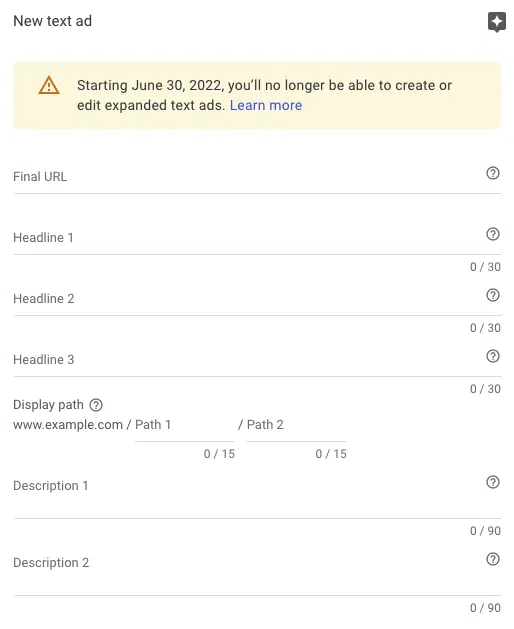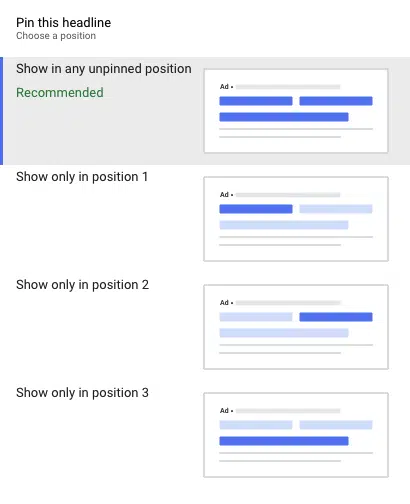Here’s How To Get Your Responsive Search Ads Ready.
Beginning on June 30, 2022, expanded text ads (ETAs) will no longer be available for creation within a Google Ads Search campaign. This change, while significant, does not come as a surprise to many. Along with the recent loss of Broad Match Modifiers, Google has made a number of significant changes to the patform recently. In February of 2021, Google modified its default ad type from ETAs to responsive search ads (RSAs). Now, with this most recent change approaching implementation, RSAs will be the only form of Search ads available for creation within Google Ads. So, what should advertisers expect from this change?
Will Your Account Be Affected?
Before 2018, ETAs were the gold standard for Google Ads accounts. For example, if your account has been internally managed or maintained, you more than likely have ETAs still being used to advertise your products or services. While ETAs are not completely disappearing (as expanded upon below), RSAs are strongly recommended by Google. It is important to anyone and everyone using Google Ads, either as an agency client or a DIY advertiser, that your RSAs are organized and structured in a way that benefits your business. In order to not rely completely on ETAs, this change may lead to necessary restructuring of campaigns.
What Exactly Is Changing?
As of June 30, 2022, advertisers will no longer be able to create or edit new ETAs. However, in a press release, Google emphasized that existing ETAs will still be presented to users during search queries. It also states that advertisers will have the ability to pause, resume, and delete these ads. The press release also noted that Google will still provide performance reports on existing ETAs.
Despite ETAs not disappearing completely, Google has evidently shifted its primary focus to strengthening its clients’ RSAs. Google strongly recommends that each ad group within a respective campaign should have at least one RSA running alongside existing ETAs.
What Is The Difference Between ETAs And RSAs?
Essentially, an ETA is a simplified version of an RSA. An ETA allows for up to three headlines and two descriptions, along with two paths and a landing page URL. This ad will display itself to users as written, and allows the advertiser the maximum amount of control over how their ad is presented to users.

An RSA, on the other hand, may present itself as several different versions to several different users. Google Ads allows advertisers to insert up to 15 headlines and up to four descriptions, while still requiring two paths and a landing page URL. Once the RSA is created, Google utilizes its machine learning algorithm to create various iterations of the ad, employing different combinations of descriptions and headlines in each one.
What Are The Benefits Of Using RSAs?
Utilizing RSAs in any campaign, while potentially inhibiting the advertiser’s creative freedom, allows for more opportunity for the advertiser and its clients. Although these two types of advertisements present themselves to users in a nearly identical way, the scope of an RSA is much larger than that of an ETA. Specifically, Google’s multivariate testing rotates versions of your RSA to receive the most impressions, clicks, and conversions, all while simultaneously ensuring your advertisements are reaching the right users.
Moreover, within any RSA, Google labels each unique headline and description as an “asset.” Once an RSA has been live for longer than 30 days, these assets are assigned a performance rating of “low”, “good”, or “best.” These asset performance reports give advertisers a deeper insight into what does and doesn’t work, and enables them to create top-performing RSAs.
As already mentioned, the nature of an RSA’s dependency on machine learning inherently leads to the advertiser having less creativite control over their advertisements. While Google doesn’t explicitly acknowledge this in its press release, it does spotlight certain Google Ads tools that advertisers can utilize to maintain a bit of oversight in reference to how an ad will present itself to a user. The pinning tool, in particular, is suggested as an option that lets advertisers dictate where a headline or a description will show up in their advertisement.
Does Pinning Make A Difference?
Pinning allows the advertiser to decide which spot a headline or description will appear in when the advertisement is presented to a particular user. For instance, if an advertisement has “Visit Our Website Today!” and “20 Percent Off Clearance” as two potential headlines, the advertiser may want the latter to be pinned to “position 1,” in order to ensure potential customers notice the advertised discount.

As Google prefers to have maximum control over RSAs, its official recommendation is to leave all headlines and descriptions unpinned, to allow for the highest number of combinations to be shown and evaluated by its algorithm. Additionally, the hosts of the popular PPC podcast “The Paid Search Podcast” concur with the recommendation from Google; both hosts agree that pinning headlines and descriptions goes against the nature of RSAs. “It’s kind of a compromise on Google’s behalf,” co-host Chris Schaeffer remarked. “They’re giving us a little bit of control in a system that’s really built for no control.”
This isn’t to say that pinning is completely ineffective; many advertisers use several variations of the same sentence or blurb to create a variety of headlines or descriptions. For example, an advertiser promoting a sale might use “20 Percent Off Sale” and “20 Percent Off Sitewide” as two separate headlines. Pinning these both to the same position ensures they won’t run alongside each other. Although this may allow for less ad combinations to be shown, it assures the advertiser that their ads will convey what is necessary to a prospective customer without potentially sounding redundant.
What Does This Mean For Your Ad Campaign?
While it may be easy to be pessimistic about a pivotal change like this that allows for less control, the opportunities that lie within utilizing RSAs in Search campaigns are considerable. In Google’s press release, it notes, “[a]dvertisers that switch from expanded text ads to responsive search ads, using the same assets, see an average of 7% more conversions at a similar cost per conversion.” In addition to this increase in conversions, RSAs reach a larger audience, and give advertisers more data to work with. An increase in conversions, coupled with an increase in data available to advertisers, may potentially result in advertisers achieving more well-rounded Search campaigns. “This move is great, because if we’re going to be focused on one ad type, then maybe there will be even more that we can do with it, because the resources will all be devoted to this one thing,” Chris Schaeffer concluded. “It could be really fun.”
Still have questions about how to get the most out of your Google Ads campaigns? Our PPC team is here to help.




